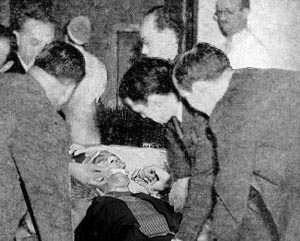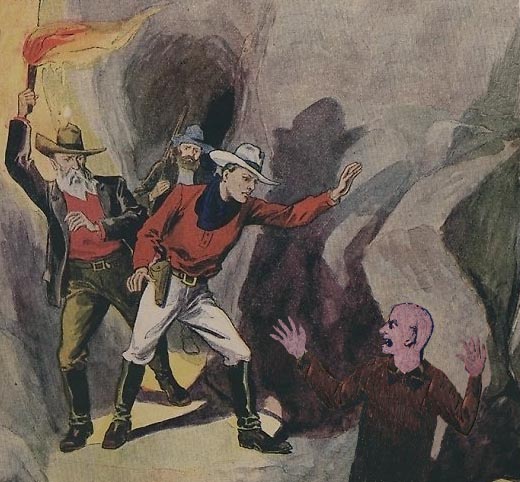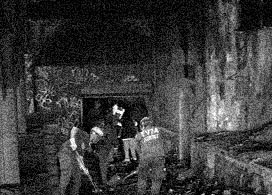

Historical Tales | News | Vampires | Zombies | Werewolves
Virtual Academy | Weapons | Links | Forum
 |
 |
Historical Tales | News | Vampires | Zombies | Werewolves Virtual Academy | Weapons | Links | Forum |
Return to Vampiric Biology
 |
|
FVZA researchers restrain a vampire being kept under observation in 1932. |
Since vampires are unable to bear children or have sex, the hunting pack is the only family unit of their life. In a successful pack, each member has its role, and there is little dissension. A typical grouping is made up of four vampires, with one Alpha and three subordinates. This tends to be the most ideal number: any more than that, not everyone always gets a chance to feed; any less and hunting becomes appreciably riskier. Of course, back in the distant past when vampire control was in a more primitive state, large vampire armies often rose up and spread by overwhelming entire towns like locusts.
Are vampires sentimental? Do they love? In a limited sense, yes. They are capable of developing loyalties and behaving selflessly to protect and serve their pack. That said, this is the only area of their lives in which they are not mercenary.
The Alpha: Vampire packs are meritocracies, not democracies; there are no elections, no "show of hands." The most capable hunter and leader runs the show, and the others follow. The Alpha vampire—also known as the Patriarch—coordinates hunting strategy, gives assignments and makes all final decisions. During hunts, the Alpha generally hangs back in a less risky position—yet when a victim is seized, the Alpha drinks first. But the job has its perils, too. For one, the Alpha has the difficult task of choosing replacements for fallen subordinates. In this, it must walk a fine line: while the Alpha must be stronger than its pack, it cannot afford to carry weak, ineffectual hunters. Contrary-wise, stronger subordinates can rise up and become a threat to its position.
 |
| "The ultimate fate of the Alpha is a grim one." |
Like virtually all mammals, vampires assert their dominance through display behavior and fighting. They will hiss and growl, bare their fangs and claws, draw weapons and showcase their prodigious strength, speed and leaping ability to intimidate rivals. Physical size and power are important but by no means the only determinant of Alpha status; in fact, intellectual capacity is more important in determining success and longevity for any vampire. If one is cunning enough, they can command minions twice their size.
While Alpha vampires seem to be in an enviable position, they actually have a higher mortality rate than their underlings. Each new challenge from within the pack takes its toll; injuries pile up, including many of the permanently-disabling variety: they can lose an eye, have flesh and ligaments torn out, and shatter bones beyond repair. As a result, elder vampires are far from the dashing, handsome types so often seen in movies, as they're likely to be heavily scarred with parts of their face missing. The ultimate fate of the Alpha is a grim one: cast out of the safety of the pack and no longer able to fight, the once-proud vampire is reduced to a solitary existence, subsisting on the blood of whatever cat or dog it can win the confidence of. Eventually, the Alpha succumbs to malnourishment or the weapons of vampire hunters.
 |
| A vampire hiding in plain sight |
Hunting: Vampires will utilize all at their disposal to hunt while avoiding detection: they will slather themselves with makeup to appear more human, have female pack members pose as prostitutes to lure male victims, and haunt the shadows around nightclubs, sporting and concert venues and all-night diners. Unsurprisingly, prostitutes and homeless always make up a disproportionate number of victims. Vampires have also been known to kill or turn taxi drivers and use their vehicles to pick up additional victims.
Much like gangs and drug dealers, a given swath of real estate can only support so many vampires. While an urban area may offer more hunting opportunities, it also increases their chances of running afoul of another pack. The country is safer, but hunting opportunities may be few and far between. Therefore, hunting packs must be ruthless in defending their territory, making such battles almost unimaginably vicious. It is not enough to merely win the confrontation: to have a future, they must show their rivals just how merciless and sadistic they can be.
Treatment of Victims: Treatment of victims can range from indifferent to barbaric. If a pack finds a suitable new member, it will keep that person in their midst until transformation is complete. Of course, they have to make sure not to drain the body too much or the person will die. Interestingly, vampires of a more traditionalist mindset have been known to perform elaborate rituals based around transforming supportive civilians into one of their kind.
Once a pack size is set, vampires will usually tear their victims apart after feeding. Some consider this behavior as proof that vampires are cruel and monstrous, but in fact it is more a question of pragmatism. Left intact, today's bite victim could become tomorrow's rival, however unlikely. Plus, it is much easier to hide severed parts than a full corpse.
Their lifestyle wasn't always this clandestine. During the Middle Ages, when vampire packs roamed the countryside without fear of extermination, they enjoyed occupying lavish digs. Once set up in these palaces, the Alpha would conspicuously display symbols of their success with all the windy self-importance of today's ruling classes.
 |
|
Agents clean up after a battle with vampires in an abandoned New York City subway station. |
Weapons: To prevent wasteful blood loss, vampires will do their best to avoid wounding victims prior to feeding. Even so much as bruising them can be detrimental, since the blood becomes trapped under the skin. When it comes to rival packs and lone investigators, vampires have no qualms using melee weapons and silenced firearms—anything that doesn't give away their position. Only during raids on their hideouts do they break out the big guns and body armor.
Despite the fact that they do not age on a genetic level, vampiric mortality rates have always been high. By the year 1800, a newly-turned vampire could expect to live 10 years on average. A century later, that number had dropped by half. And then by 1960, life expectancy encompassed a couple years at most. The leading causes of death have also changed with the times. During the Middle Ages, vampires were frequently murdered by other vampires—an act known as vampiricide—usually over long-lasting disputes involving territory and human trafficking. By 1930, the exponential rise of skilled and organized vampire hunters had become their greatest killer, partly in thanks to the Great Depression and its atmosphere of desperation.
Suicide rates are also much higher among vampires than humans. For much of the 20th century, suicide rates in the United States hovered between 10 and 15 suicides per 100,000 people; and vampires were easily triple that number. However, even that estimate is probably low, because many vampires who succumbed to malnutrition had made a conscious decision to stop feeding. Still, the Vanguard would handle vampiric suicide reports on a weekly basis. They would fling themselves off buildings and in front of trains and trucks, light themselves on fire, take poison or shoot themselves in the head, among other dramatic methods. Artery cutting and organ stabbing usually met with failure, while sun exposure was only moderately successful.
Population: As of today, the world's vampire population is estimated to be approximately 5,000. The vast majority of this estimate (95 to 98 percent) are believed to be in the dormant phase. As the FVZA and other organizations around the world made significant progress in vampire abatement during the 1950s and 60s, many vampires went into hiding, hoping to reawaken at a more hospitable time. Unfortunately, seeing as how the FVZA has been out of commission for over 40 years, this day and age would be the perfect time for them to emerge.
 |
| Global distribution of likely vampire hideouts, marked in red |
Politics: Contrary to the clichéd notion of good and evil vampires, it's arguably more useful to categorize them as either Elitists or Populists. Naturally, the vast majority of vampires are Elitists who want to keep their numbers small to avoid drawing attention or rivalry. Occasionally, a Populist will emerge to promote the idea of significantly expanding the ranks of their species. Nevertheless, Elitists have always controlled the agenda and they brook no dissent.
 |
| Shiva the Destroyer |
For another example of vampiric cult practices, see the Historical Tale for The Order of the Broken Cross.
 |
| The Black Book |